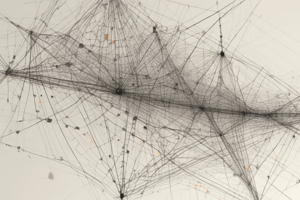Podcast
Questions and Answers
What is the main difference between directed and undirected graphs?
What is the main difference between directed and undirected graphs?
- Directed graphs have more vertices than undirected graphs.
- Directed graphs have ordered pairwise relationships, while undirected graphs lack directionality. (correct)
- Undirected graphs have cycles, while directed graphs do not.
- Undirected graphs have weighted edges, while directed graphs do not.
Which concept in graph theory involves assigning personnel to job positions?
Which concept in graph theory involves assigning personnel to job positions?
- Graph modeling (correct)
- Depth-first search
- Graph traversals
- Breadth-first search
What do breadth-first search (BFS) and depth-first search (DFS) algorithms help with in graph theory?
What do breadth-first search (BFS) and depth-first search (DFS) algorithms help with in graph theory?
- Identifying connected components (correct)
- Detecting cycles
- Finding the shortest path
- Updating edge weights
In the context of big graph analytics, what do novel techniques aim to handle efficiently?
In the context of big graph analytics, what do novel techniques aim to handle efficiently?
What emerging trend in AI involves using graph neural networks (GNNs) for solving various tasks?
What emerging trend in AI involves using graph neural networks (GNNs) for solving various tasks?
Why is graph theory considered an indispensable toolset for tackling complexity?
Why is graph theory considered an indispensable toolset for tackling complexity?
What do vertices or nodes represent in graph theory?
What do vertices or nodes represent in graph theory?
Which of the following is NOT a core concept of graph theory?
Which of the following is NOT a core concept of graph theory?
How do computer scientists use graphs in artificial intelligence (AI)?
How do computer scientists use graphs in artificial intelligence (AI)?
What is the role of edges in graph theory?
What is the role of edges in graph theory?
Which area of computer science utilizes graphs for structural analysis and simulation?
Which area of computer science utilizes graphs for structural analysis and simulation?
What lies at the core of graph theory's application in computer science?
What lies at the core of graph theory's application in computer science?
Study Notes
The Mathematical Foundation of Graph Theory within Computer Science
Graph theory, a branch of mathematics, plays a crucial role in the foundational elements of computer science due to its ability to represent diverse real-world scenarios and model relationships effectively. While the following discussion focuses primarily on graph theory's contribution to computing, it also highlights overlapping areas where mathematics and computer science converge.
Fundamental Applications
Computer scientists frequently utilize graphs to solve complex problems across domains such as networking, artificial intelligence (AI), game theory, database management systems, and natural language processing. One notable example lies in social networks, where nodes correspond to individuals or entities, and edges capture interactions or relations among them.
Additionally, graphs serve as a structural blueprint for analysis, optimization, and simulation in many computing disciplines. Examples range from determining optimal routes in logistics to optimizing scheduling problems in business and resource allocation issues.
Core Concepts of Graph Theory
In graph theory, vertices or nodes denote objects, whereas edges demonstrate the relationship between pairs of nodes. Basic concepts such as adjacency matrices, paths, cycles, connected components, minimum spanning trees, and shortest path algorithms lie at the core of its application in computer science.
Another pivotal aspect is the distinction between directed and undirected graphs. Directed graphs exhibit ordered pairwise relationships, while undirected ones lack directionality, conveying only binary presence or absence. Both forms facilitate modeling distinct scenarios according to the nature of the situation being analyzed.
Real-World Connections
Regarding the intersection of mathematics and computer science, graph theory embodies the power of abstraction, enabling insights into vastly divergent systems. For instance, consider the assignment of personnel to various job positions, which closely resembles the problem of assigning knights to squares on a partially filled chessboard with certain constraints—both instances can be described through graph theory.
Moreover, graph traversals, such as breadth-first search (BFS) and depth-first search (DFS), illustrate how mathematical algorithms translate into functioning code solutions for locating paths, detecting cycles, and identifying connected components in networks. Thus, graph theory underscores the vital role played by mathematics in computer science.
Challenging Problems and Future Directions
As graph theory evolves alongside technological advancement, new challenges emerge. For instance, big graph analytics requires novel techniques to handle colossal datasets efficiently, promoting collaboration among disciplines like distributed systems, parallel computing, and scalable databases. Additionally, emerging trends in AI incorporate graph neural networks (GNNs) in solving tasks ranging from recommendation systems, fraud detection, to natural language processing.
To summarize, graph theory offers an indispensable toolset for tackling complexity inherently embedded in both computational models and physical phenomena, thereby emphasizing the symbiotic relationship between mathematics and computer science.
Studying That Suits You
Use AI to generate personalized quizzes and flashcards to suit your learning preferences.
Description
Explore the fundamental role of graph theory in computer science, covering its core concepts, real-world applications, and the synergy between mathematics and computing. Learn about the essential tools and techniques used to model relationships, solve complex problems, and optimize various computational processes.




